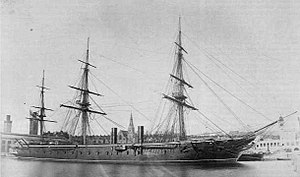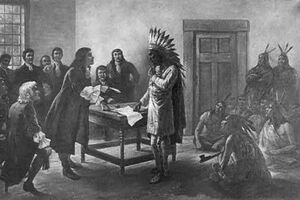Modern Era
This article is a work in progress. Any information here may not be final as changes are often made to make way for improvements or expansion of lore-wise information about Gentu. Please comment on this article's talk page to share your input, comments and questions. Note: To contribute to this article, contact User:Philimania. |
| Part of a series on the |
| History of Gentu and Gentish human history (Hodiernus epoch) |
|---|
| ↑ before Homo (Septun epoch) |
|
Prehistorical Era (one-era three-age system) |
|
| Ancient Era |
|
| Antiquity Era |
|
| Middle Era |
|
| Modern Era |
|
| ↓ Future |
The Modern Era, also known as the Contemporary Era (not to be confused with the Contemporary Age), is the period of human history that runs from 1589 to the present day. The era is divided into 3 ages: the Early Modern Age, Middle Modern Age, and the Contemporary Age.
Variously demarcated by historians as beginning with the start of the Great Enlightenment, historians in recent decades have argued that from a worldwide standpoint, the most important feature of the Early Modern Age was its spreading globalizing character. New economies and institutions emerged, becoming more sophisticated and globally articulated over the course of the period. This process began simultaneously in Oranland and Hesterath although some sources argued it had first begun in the Veragese Collective. It also included the rise of the dominance of the economic theory of mercantilism.
The Middle Modern Age meanwhile, is marked by the beginning of the Industrial Revolution in 1760. The period also saw widespread improvement and development in technology such as the invention of the steam engine and an early telephone. In addition to these improvements, the early half of the Middle Modern Age is regarded by many historians as the Golden Age of Slavery. In Naphtora, the Naphtoran Conquests beginning in 1870 saw the rise of the Anti-Colonial League led by Neo-Calidum in 1873. The Middle Modern Age also included the rise of the relatively new Volkist ideology.
With the end of the Great Games and the start of the Great War in 1918, the Contemporary Age begun. The age was characterized by the end of the colonialism with the last major colony gaining independence from XXX in 1983. It also saw the landing of the first man on Cynthia in 1976 and many other technological advances due to competition for influence over Gentu between XXX and XXX. The age also comprised the start of the unofficial Verandere Epoch in 1950.
Early Modern Age
Beginning in 1589, the Early Modern Age is distinguished by the beginning of the Great Enlightenment and its globalizing character.
The Great Enlightenment was triggered by the resurgence of trade between Hesterath, Oranland, Naphtora, the Domicas, Alabon, Flonesia, and Trimeshia. This resulted in the amplified spread of ideas and inventions throughout the continents. In Trimeshia, the Oranish powers colonized the continent with Neragese influence in the east and Palon influence in the west.
In Naphtora, a coup in Neo-Calidum leads to the establishment of the Neo-Calidum Empire in Okjatab of 1623. Under the reign of Sehiman the Great, the Neo-Calidum Empire conquered most of northern Naphtora and some of what remained of the Dardonan Empire. Throughout the Modern Era, Science and learning flourished throughout the empire, but particularly in its early centuries. Neo-Calidum had contributed to the development of hospitals and healthcare, and witnessed advances in medicine, mining and military technology. They also set up a leading observatory in Neo-Odius and had established more than 300 institutes for learning.
The idea of a unified state spreaded to northern Hesterath around the mid 17th century. It resulted in the emergence of the so-called Northern States. They stayed disunited until 1710 with the start of the First Northern War ending with the establishment of the Eudocian Republic in 1716 and Omaran occupation of the western half of northern Hesterath. In the Lowlands, the Zhao continues to flourish due to trade while the Shanji continues its practice of isolationism.
In the Domicas, war erupts between the Paqueon and Neragese Empire in 1602. The war, later known as the War of 1602, spanned the regions of Oranland, the Domicas, Flonesia, and some of Hesterath. It included 7 combatants and was fought over a period of 13 years, ending in Enero of 1615. Although the war ended in a stalemate, it resulted in the Terranist Divide in 1618 which in turn, led to the divide of the Terranist Church into the Paxist and Altenic Church, the Paxists promoting pacifism more strongly then Terranism while Altenics only wanted to be left alone.
Around 1750, the Slave Network was formed. It involved the transportation by slave traders of sold and enslaved Naphtoran people, mainly to the Domicas. The vast majority of those who were enslaved and transported in the Slave Network were people from central and west Naphtora that had been sold by other Naphtoran to Oranish slave traders, while others had been captured directly by the slave traders during frequent tribal wars that occurred. Oranish slave traders gathered and imprisoned the enslaved at forts on the Naphtoran coast and then brought them to the Domicas. The South and Central Domican economies were particularly dependent on labour for the production of sugarcane and other commodities.
TBA
Middle Modern Age
The Industrial Revolution begun in 1760 with the invention of the Spinning frame, ushering in the Middle Modern Age. The age ended in 1918 with the conclusion of the Great Games and the start of the Great War.
The Industrial Revolution, introduced many new inventions to Gentu, such as the steam engine, invented in 1784; the electrical telegraph in 1837; and the telephone in 1876. These new inventions changed lives of many people and helped make communication and transportation easier throughout the many empires.
Hesterath
In Hesterath, in response to a refusal to trade with Seronia-Sotha, they declared war on the Shanji dynasty in 1769 this led to a Serono-Sothan victory and the Shanji was forced to cede a few islands of the coast of Horapon to Seronia-Sotha which would later develop into the Serono-Sothan trading city and colony of Nowy Shoto. In 1772 the Zhao dynasty plunges into civil war after the death of the king. The war eventually concluded with the treaty of XXX in 1786 with the Zhao dynasty divided into north and south: the Easu controlled Yang dynasty in the north, and a Qiu controlled Nanchao dynasty in the south.
In 1778, the Second Northern War begins when the Omaran declares war on the Eudocian Republic. The war eventually ended in 1784 with the Omaran Empire kicked out of northern Hesterath and the establishment of a Neragese colony in the region. 23 years later, in 1807, the Farhad people revolts against the Omaran Empire resulting in the Third Northern War. The war ended in another Omaran defeat, the expansion of the Neragese colony in the region, and the establishment of the Farhad Federation in 1814.
In 1823, the Nanchao dynasty ceded 118 square kilometres of land on the XXX river delta to the Palon Empire as a sign of cooperation. The piece of land would later be known as Hoy Kok. Around the same decade, in 1826, the Yang dynasty would enter a period of isolation just like the Shanji did on Horapon.
Around the mid-19th century, the first steam warship was developed in Nanchao. Although the exact time of its creation and the person who invented it is still a mystery, the new concept spreaded quickly across the known world and completely revolutionized naval warfare. The first large scale usage of this new type of warship was in 1867 at the Battle of the Neragese Channel during the Cavalan War of Independence in Oranland.
In 1874, the Omaran Empire aquired a colony in Naphtora during the Naphtoran Conquests before they were expelled from the continent by the Neragese in 1894.
The Goldern Four
The Golden Four was the name given to the 4 continents of North and South Domica, Naphtora, and Oranland. The reason as to why they were called this was because they were the main locations of the Slave Network. The early half of the Middle Modern Age is regarded by many historians as the Golden Age of Slavery.
The Industrial Revolution in Oranland brought about the first factory in 1768, which was a textile factory. Over the next few decades, more and more factories popped up in the countryside resulting in the creation of new settlements which in turn led to the foundation of a more complex social hierarchy. However, these new changes also introduced a larger wealth gap throughout Gentu. Resulting in the rich getting richer and the poor getting poorer. Because of this, the new Volkist ideology developed in the southern principalities of the Veragese Collective.
In North Domica, an expensive war between the Chokaw Confederacy and the Neragese Empire in 1772, known as the Warkhan War, leads to a Neragese victory and the annexation of Chokaw. But because of how costly the war was, the Chokaws and a group of Oranish defectors were able to continue fighting using guerrilla warfare against the Neragese until 1778 when they overthrew the Neragese northern colony in North Domica when Neragon was diverting its resources to Hesterath during the Second Northern War. This eventually resulted in the Chokaw Independence War which ended in 1789 in a Chokaw victory. These chain of events inspired many other people oppressed by the empires in the Domicas to revolt against them.
From 1770 onwards, demonstrations in Oranland organized by workers and miners would occur. Although, none of them were successful, it resulted in the legalization of trade unions in Neragon, Palon, and Seronia-Sotha. Trade unions were organizations of workers who had came together to achieve common goals, such as protecting the integrity of their trade, improving safety standards, and attaining better wages, benefits (such as vacation, health care, and retirement), and working conditions through the increased bargaining power wielded by solidarity among workers. However, places that did not act quick enough led to more violent and frequent demonstrations. This eventually led to the Cavalan Revolutionary War in 1812. Inspired by the Chokaw's war, they united the southern Veragese principalities into the Cavalan Republic in 1816.
Due to Cavala's rapid expansion, the Anti-Cavalan Coalition led by the Principality of Serida and Seronia-Sotha was formed in Kunnen of 1816. This prompted the Great Coalition War in 1817 which ended in 1820 in a Decisive Cavalan victory, managing to aquire 2 colonies in Flonesia.
TBA
Flonesia and Trimeshia
TBA
Contemporary Age
This section needs to be updated. (March 2022) |
TBA
Timeline
TBA
By region
TBA
Maps
TBA




